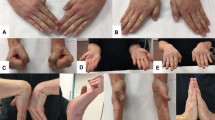Abstract
Background:
Although an increased tendency towards pathologic fractures has been described in patients with pycnodysostosis, little data is available with respect to fracture management in this unique group of patients.
Case Study:
Our case study illustrates the technical difficulties and possible alternatives in the management of a diaphyseal femur fracture in a 6-year-old child with pycnodysostosis. Conservative management with plaster cast and surgical treatment with elastic stable intramedullary nailing both failed. A wrist external fixation device (Pennig, Rx medical) proved to be adequate and led to complete union of the fracture.
Conclusion:
The Pennig wrist external fixation device offers an excellent treatment option in children with pycnodysostosis who develop a transverse diaphyseal femur fracture.
Similar content being viewed by others
Author information
Authors and Affiliations
Corresponding author
Rights and permissions
About this article
Cite this article
Jiya, T.U., Hindriks, M., Kleipool, A. et al. Diaphyseal Femur Fracture in Pycnodysostosis Treated with Pennig Wrist External Fixator: a Case Study. Eur J Trauma 32, 477–479 (2006). https://doi.org/10.1007/s00068-006-5085-6
Received:
Accepted:
Issue Date:
DOI: https://doi.org/10.1007/s00068-006-5085-6




